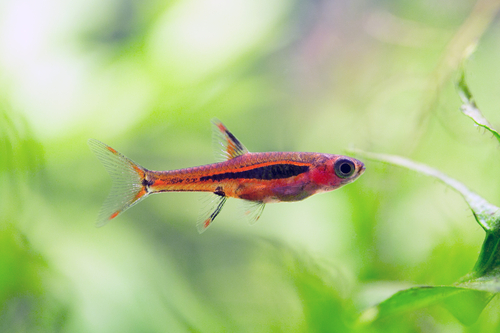Welcome to the vibrant world of Chili Rasboras, also known as Mosquito Rasboras. These tiny, lively freshwater fish have won the hearts of aquarists worldwide thanks to their striking colours and dynamic nature.
Hailing from the blackwater streams, pools, and peat swamps of southern Borneo, these petite schooling fish are not just a feast for the eyes but are also highly adaptable and easy to care for, making them an ideal choice for nano aquariums.
Chili Rasboras are characterized by their slender bodies and pointed fins, which together create an elegant silhouette. Their fiery red colour, reminiscent of chilli peppers, is what gives them their name and makes them stand out in any aquarium.
Despite their vibrant appearance, these fish have a mild temperament and can coexist peacefully with other small fish in a community tank.
Typically found in densely planted environments, Chili Rasboras thrive best in well-maintained aquariums with stable water parameters. A diverse diet is key to their health and longevity, ensuring they maintain their vibrant colours and active behaviour.
Whether you’re considering adding Chili Rasboras to your tank or simply intrigued by these colourful creatures, let’s dive deeper into their world, exploring their origins, physical traits, behaviour, and the essentials of providing a healthy, thriving environment.
Contents
Key Takeaways
- Chili rasboras are small, vibrant fish native to peat swamps in southern Borneo.
- Their mild temperament makes them ideal for nano community aquariums
- Proper care includes a stable aquatic environment, a diverse diet, and suitable tank mates
Don’t miss out on these other top posts in this category:
Natural Habitat and Distribution

Chili Rasboras (Boraras brigittae) are native to the swamps of southwestern Borneo, Indonesia and can be found within the provinces of Kalimantan Tengah and Kalimantan Selatan in Southeast Asia.
These tiny, captivating creatures thrive in the tranquil waters of blackwater streams, pools, and rivers, which are often surrounded by lush, dense greenery.
The environment in these streams and pools is characterised by soft water and very low pH. Habitat destruction, specifically the loss of ancient peat swamps, poses a severe threat to the Chili Rasboras, despite not being covered by the IUCN.
These fish are endemic throughout southeast Borneo, indicating that they are only found in this specific region. In their natural habitat, Chili Rasboras frequent slow-moving or still waters, such as small lakes, swamps, and forested water settings.
They prefer densely vegetated waters, where they can quickly dart in and out of hiding spots. This attribute is one of the reasons why they are so enjoyable to observe in aquariums.
Appearance
The Chili Rasbora is a small, attractive fish known for its vibrant colours and sleek appearance. Its body is adorned with a metallic red color which can vary in intensity depending on factors such as mood, age, and health.
The fish’s scales are highly reflective, shimmering beautifully in the light and creating a mesmerising effect that captivates hobbyists and onlookers alike.
In terms of size, Chili Rasboras are considered micro or nano fish, typically reaching only 0.5 to 0.8 inches in length when fully mature. Their torpedo-shaped bodies are complemented by large, expressive eyes, which add to their overall charm.
When it comes to distinguishing between males and females, there are some subtle differences in their appearance. Males tend to have a more intense red colouration, while females are often slightly paler.
In addition, females may exhibit a rounder body shape due to the presence of eggs, making them appear slightly larger and less streamlined than their male counterparts.
Behaviour and Temperament

The Chili Rasbora is an appealing addition to any aquarium due to its peaceful and active behaviour. As a schooling fish, they thrive in groups of six or more individuals, which enriches the visual appeal of an aquarium and creates a more natural and stress-free environment for them.
These tiny freshwater fish can occasionally exhibit shy and timid characteristics, especially when first introduced to a new environment or housed with larger or more aggressive tank mates.
It is essential to provide them with suitable hiding spots and a secure environment to help them feel comfortable and display their natural behaviours.
Chili Rasboras are known to be active fish that spend much of their time swimming and exploring the aquarium. Their playful antics add a sense of movement and energy to the tank.
If provided with the correct conditions, such as suitable water parameters and ample swimming space, their activity levels will remain consistent throughout their lives.
Tank Requirements
Chili Rasboras are a popular choice for aquarium enthusiasts due to their small size and vibrant colours.
To ensure the health and happiness of these fish, it’s important to provide them with an appropriate living environment. When setting up a tank for Chili Rasboras, consider the following tank requirements:
Chili Rasboras thrive in nano tanks or community tanks that are at least 5 gallons in size. A larger tank of 10 gallons or more is advisable if you plan to include other species in the community or if you want to create a more comfortable environment for a school of Chili Rasboras. You can review more details in Tankarium’s Care Guide.
Substrate selection is crucial for creating a suitable habitat for Chili Rasboras. A dark substrate is recommended, as it closely resembles their natural environment and helps to showcase their vibrant colours.
Fine sand or small-grained gravel works well, providing a smooth surface for the fish to swim over without injuring themselves. Additionally, proper water parameters must be maintained to ensure the health and well-being of Chili Rasboras.
The water temperature should be within the tropical range of 68° to 83° Fahrenheit, with a pH range of 4.0 to 7.0 and water hardness between 1 to 10 dKH. For more information, refer to the care guide on Fish Laboratory.
To mimic their natural habitat, provide plenty of hiding spots and cover for the fish in the form of live plants, driftwood, and rocks. This creates a more stimulating environment and encourages natural behaviour.
A well-planted tank with floating plants or moss also helps maintain stable water parameters.
Water Parameters
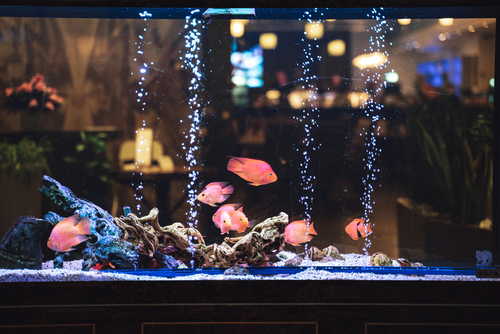
Chili Rasboras thrive in specific water conditions that mimic their natural habitat. Ensuring these parameters are met in your aquarium will help promote their health and well-being.
In their natural environment, Chili Rasboras live in soft, acidic waters. To replicate these conditions, maintain a pH between 6.0 to 7.0, which falls within the low pH range. Using distilled water or water treated with reverse osmosis can be beneficial in achieving the desired softness and acidity.
The water hardness, measured in dGH, should be kept within 4 to 12 dGH for optimal conditions. Water quality is crucial for Chili Rasboras, as these fish are sensitive to fluctuating levels of dissolved minerals. Regular testing with a reliable test kit is necessary to maintain these values consistently.
Temperature is another critical factor to consider. Create a comfortable environment by maintaining a temperature range between 72 to 82°F (22 to 28°C). This tropical range ensures that the fish remain active and healthy.
Aquascaping and Planting
Providing a planted environment is essential for creating a comfortable and natural habitat in a Chili Rasbora aquarium. Introducing live plants helps improve water quality, creates shelter, and reduces stress for the fish.
Begin by choosing a soft, dark-coloured substrate, which will serve as an ideal base for planting.
Java Moss and Java Fern are two aquatic plants well-suited for a Chili Rasbora tank. These plants are ideal due to their low maintenance requirements and ability to adapt to different lighting conditions. Additionally, they provide ample hiding spaces for the fish.
Floating plants, such as Frogbit and Salvinia, can also be incorporated into the aquarium as they provide shade, contribute to water purification, and create a captivating environment for the fish.
The Chili Rasbora thrives in a blackwater setting, which can be achieved by introducing tannins into the water.
Tannins are natural compounds found in various botanical items, such as almond leaves. These leaves release tannins when submerged, imparting a dark, tea-like tint to the water, mimicking the fish’s natural habitat.
Almond leaves also offer additional benefits, including enhancing the colours of Chili Rasboras and providing antibacterial properties.
Diet and Feeding

Chili Rasboras are omnivorous fish, meaning they can consume both plant and animal matter. They require a balanced and consistent diet of high-quality foods and some essential live food options to remain healthy and vibrant.
One of the most important aspects of feeding Chili Rasboras is providing food that is of an appropriate size. Due to their small size and tiny mouths, they can struggle to eat larger, more common fish foods.
To ensure that your Chili Rasboras consume enough nutrients, offering them a diverse menu is vital.
An ideal diet for Chili Rasboras would include micro worms, baby brine shrimp, and infusoria. These live or frozen options are small enough for the fish to consume easily and are rich in protein, which is essential for their overall health and growth.
It is also possible to supplement this menu with professionally prepared foods such as micro pellets or powder, as long as they are finely ground, making them easier for Chili Rasboras to ingest.
Apart from live food, Chili Rasboras also appreciate vegetable matter. You can provide some variety in their diet by offering spinach, lettuce, or other leafy greens, finely chopped, and placed into the aquarium.
When feeding your Chili Rasboras, it is crucial to maintain a consistent schedule. The recommended frequency for feeding is once or twice a day in small portions. It’s essential to avoid overfeeding your fish, as this can lead to poor water quality and adversely affect the fish’s health.
By providing a varied and appropriate diet to your Chili Rasboras, you ensure that they will thrive in your aquarium, displaying their beautiful colours and playful personalities to the fullest.
Tank Mates and Compatibility
Chili rasboras are peaceful and small tropical fish that make an excellent addition to a community aquarium. Finding compatible tank mates for Chili rasboras is essential to ensure their safety and well-being. Here are some suitable tank mates that can coexist harmoniously with Chili rasboras.
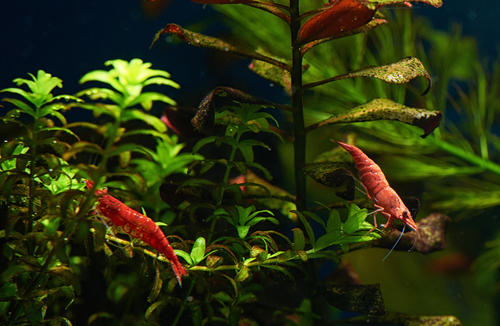
When it comes to shrimp, cherry shrimp and amano shrimp are great choices. These shrimp species are small, non-aggressive, and beneficial to the tank as they eat algae and help maintain a clean environment.
Certain gourami species, like sparkling gourami and chocolate gourami, can also coexist well with Chili rasboras. These gouramis are beautiful and peaceful, making them suitable companions for Chili rasboras.
However, it’s important to note that gouramis should be kept in pairs or small groups to avoid territorial disputes among themselves.
Celestial pearl danios and neon tetras are excellent choices for other small fish species. Both species are peaceful, tropical fish that thrive in similar water conditions as Chili rasboras. Additionally, their vibrant colours and schooling behaviour add visual interest to the aquarium.
Breeding
Chili Rasboras, also known as Boraras Brigittae or Mosquito Rasboras, are small schooling fish that add vibrant colours to freshwater aquariums. Breeding these eye-catching fish is a rewarding experience for aquarists.
This section will provide a brief yet confident and knowledgeable overview of the breeding process for Chili Rasboras.
When preparing for breeding, it’s crucial to set up a separate breeding tank of at least 5 gallons in size. The water should be soft and slightly acidic, with a temperature ranging from 78°F to 81°F.
Adding aquatic plants, such as Java Moss or spawning mops, can create a comfortable environment and provide hiding spots for the eggs.
To encourage breeding behaviour, it is essential to incorporate a high-quality diet for the adult fish. Feeding them with live or frozen foods, such as daphnia, bloodworms, and brine shrimp, will ensure their optimal health and readiness for breeding.
Keeping the lights on for a more extended period of time per day might also help with simulating natural conditions for spawning.
Chili Rasboras are known to be egg scatterers, so aquarists can expect them to lay their eggs among the plants or spawning mops. Separating the adults from the eggs is necessary to protect the eggs, as the parents might consume them if left together.
It’s essential to maintain pristine water conditions and keep any light exposure minimal to ensure the safety and health of the eggs.
After about 18 to 36 hours, the eggs will hatch and the fry will start to emerge. At this stage, they can be fed with infusoria and other small food items, like baby brine shrimp.
It’s crucial to continually monitor and maintain water quality during this time to ensure the fry’s survival and growth. After a few weeks, when the fry is big enough, they can join the main group or school in the community tank.
Health and Lifespan
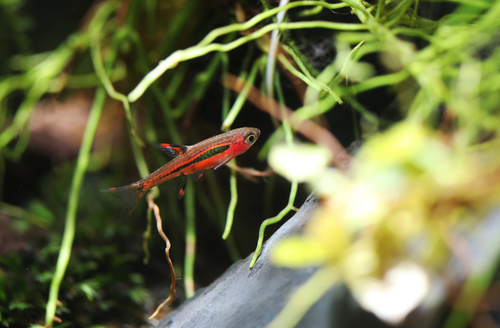
Chili Rasboras are generally hardy and easy to care for, making them suitable even for beginners in the aquarium hobby. Their lifespan typically ranges from 4 to 8 years, depending on the quality of care they receive. Maintaining proper water parameters and a stable environment is essential to ensure their overall health and longevity.
Stress can significantly impact the health of Chili Rasboras, making them more susceptible to diseases and possibly shortening their lifespan. Common causes of stress among fish include sudden changes in water conditions, overcrowding, and improper diet.
To minimise stress, be sure to provide a tank with enough space for the fish to swim freely and hiding spots for them to feel secure.
Diseases affecting Chili Rasboras can usually be traced back to poor water quality. Maintaining a clean and stable environment is essential for the well-being of these fish.
Regular water changes, proper filtration, and adequate oxygen levels will reduce the risk of common diseases such as ich, fin rot, and fungal infections . It is also crucial to quarantine new fish before adding them to an established tank to prevent the spread of any infections.
Feeding Chili Rasboras a balanced and varied diet is essential for their health. These fish are omnivores, requiring a mix of high-quality dry foods, live and frozen items. A proper diet will not only ensure their overall health but also help prevent diseases stemming from malnourishment or poor diet.
Chili Rasbora Care
If you’re looking to always maintain a splash of color and activity in your aquarium, consider prioritizing chili rasbora care. These tiny fish only grow to about an inch long, but their bright red bodies make them stand out.
Chili rasboras are schooling fish, so you’ll want to keep them in groups of 6 or more. This allows them to exhibit their natural schooling behavior as they swim together, constantly changing direction in an energetic display.
When it comes to Chili Rasbora care, one of the best things to do is to maintain soft, acidic water with a pH between 6-7. Because of the small chili rasbora size, they do best in a well-planted tank with lots of hiding spots.

Also, avoid aggressive chili rasbora tank mates so that they won’t be eaten up or bullied.
With their striking coloration, active nature, and minimal care requirements, chili rasboras are a great option to liven up a nano tank. Just be sure to keep them in groups and provide ample vegetation so they can exhibit their best behaviors.
Chili Rasbora Fry and Juvenile Care
Chili Rasbora fry hatch approximately 18-36 hours after the eggs are laid. The tiny transparent fry initially measures around 2-3 mm long and requires infusoria, finely powdered fry food, or liquid protein products to support its rapid growth.
They may also forage on microorganisms and biofilm from surfaces in the tank. Provide dense planting for hiding and maintaining high water quality.
Growth accelerates around 2 weeks and by 6-8 weeks, juvenile Chili Rasboras reach 5-7 mm long and can transition to newly hatched brine shrimp and micropellets.
Ensure they are growing robustly before introducing them into a community aquarium.
Heating and Filtration
Heaters are vital for maintaining the recommended water temperature of 72-82°F. Select a slim submersible heater correctly sized for the aquarium volume. Place it horizontally near the filter outlet to evenly distribute heat.
For filtration, a hang-on-back or sponge filter with adjustable flow works well. Aim for 4-5 times the turnover rate per hour position inlet and outlet to minimize disturbance of floating plants while permitting adequate circulation. Perform regular filter cleaning to prevent clogged media.
Additional Care Information
Chili Rasboras are a great option for beginner aquarists because they are easy to care for, beautiful, and tiny. With their small size and vibrant coloration, they make a stunning addition to any freshwater fish aquarium.
When it comes to Chili Rasbora care, maintaining pristine water conditions is essential. These tropical fish prefer soft, slightly acidic water with a pH between 5.0 and 6.4. Regular water changes and monitoring of the water parameters are crucial to ensure the health and well-being of these fish.
Additionally, providing a diet filled with high-quality foods will fulfil their nutritional needs and keep them in good shape. As omnivores, Chili Rasboras appreciate a mix of dry food like flakes or pellets and live or frozen foods such as daphnia, brine shrimp, and micro worms. Providing a varied diet will keep them healthy and display their best colors.
Chili Rasboras are peaceful schooling fish, so it’s vital to keep them in a group of at least six or more individuals. This helps them feel secure and ensures that their natural shoaling behavior can be observed.
A planted aquarium with plenty of hiding spots will make these fish feel at home and help reduce stress.
One essential aspect of Chili Rasbora care is ensuring compatibility with tankmates. Since these fish are quite small and delicate, they do best in a community tank with similarly sized species and a calm temperament.
Avoid placing them in an aquarium with larger or aggressive fish, as their small size makes them vulnerable.
Finally, Chili Rasboras prefer a stable environment with a temperature range between 75 and 81 degrees Fahrenheit. Keeping the aquarium’s temperature consistent and providing proper filtration will contribute to its overall health and longevity.
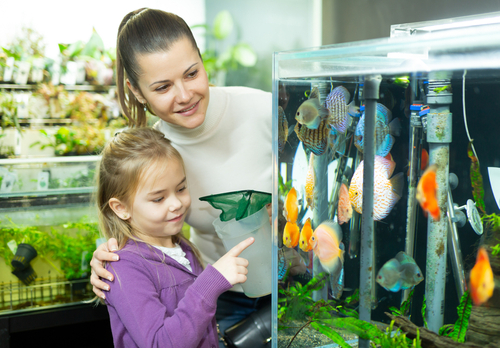
Taxonomy and Species Information
The Chili Rasbora, scientifically known as Boraras brigittae, is a captivating nano-schooling fish native to Western Borneo. It is often mistaken for the Phoenix Rasbora due to their similar appearance and behaviour.
Belonging to the Boraras genus, these tiny fish have become increasingly popular in the aquarist community thanks to their vibrant colours and peaceful temperament.
Originally described by Dieter Vogt in 1978, Chili Rasboras are often misclassified within the Rasbora family. However, they’re technically not part of the Rasbora family but are members of the Rasborinae subfamily.
Their striking appearance and small size make them ideal for nano aquarium setups, particularly those aiming to mimic their natural habitat.
Chili Rasboras are micro predators, feeding on small invertebrates in the wild. In captivity, they thrive on a diet of high-quality flakes, frozen or live foods such as daphnia, brine shrimp, and micro worms.
As a schooling fish, it’s best to keep Chili Rasboras in groups of 12 or more to ensure they feel safe and display their best behaviours.
Frequently Asked Questions
How many Chili rasboras should be kept together?
Chili rasboras are schooling fish, which means they thrive in groups. It is recommended to keep them in groups of at least 8 to 10 individuals to maintain their natural behaviour and reduce stress.
Keeping them in larger groups can also enhance their vibrant colours and encourage more active swimming patterns.
Will Chili Rasbora eat shrimp?
Chili rasboras are generally peaceful fish and can coexist with other small, peaceful tank mates such as shrimp. However, smaller shrimp, like baby cherry shrimp, might be at risk of being eaten by hungry rasboras.
It is advisable to provide hiding spots for shrimp and monitor the tank carefully to ensure a harmonious community.
Do chili rasboras need blackwater?
Chili rasboras do not necessarily require blackwater conditions, but they do prefer soft, slightly acidic water. While some hobbyists successfully keep them in blackwater tanks, it is not a strict requirement for their care.
The most important factor is maintaining consistent water parameters and ensuring high water quality.
What fish can go with chili rasboras?
Chili rasboras are compatible with other peaceful, small fish that thrive in similar water conditions. Some suitable tank mates include otocinclus catfish, pygmy corydoras, ember tetras, and small, non-aggressive shrimp species.
Avoid housing them with larger or aggressive fish that may see them as food or cause stress.
How big do chili rasboras grow?
Chili rasboras are considered nano fish, with adults reaching a maximum size of 0.7 to 1.2 inches (1.8 to 3 cm). Their small size makes them an excellent choice for nano tanks and those with limited space.
What is the ideal tank size for chili rasboras?
Due to their small size, chili rasboras can be comfortably housed in tanks as small as 5 gallons. However, a 10-gallon tank or larger is recommended to allow for sufficient swimming space and to accommodate the schooling behaviour of the fish.
A larger tank would also provide more stability in the water parameters, ensuring a healthier environment for the rasboras and their tank mates.

Ian Sterling, founder of Fishlab.com, began his aquarium journey over 30 years ago, driven by a deep fascination for fish and their diverse personalities. His website, Fishlab.com, is dedicated to making fishkeeping accessible and enjoyable, offering beginner-friendly guidance, expert insights, and a community for aquarists to connect and share experiences.


